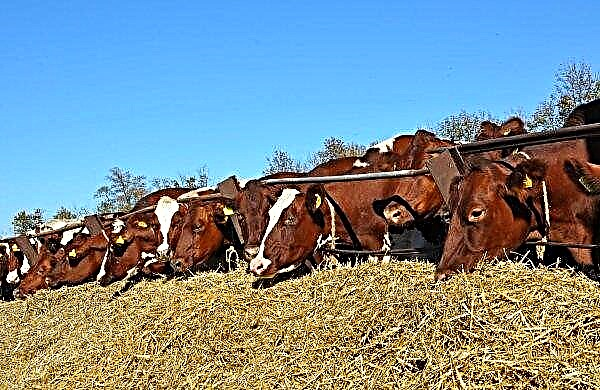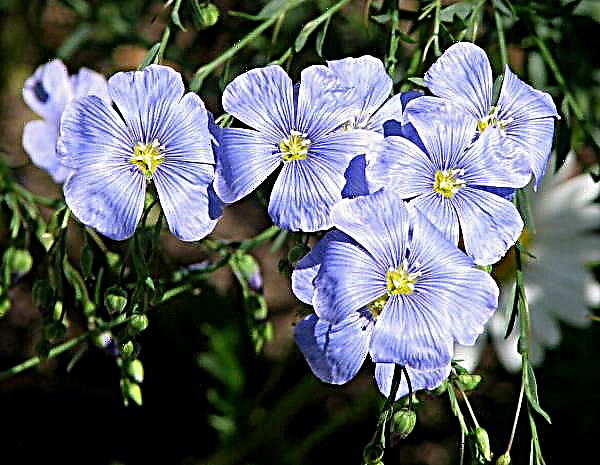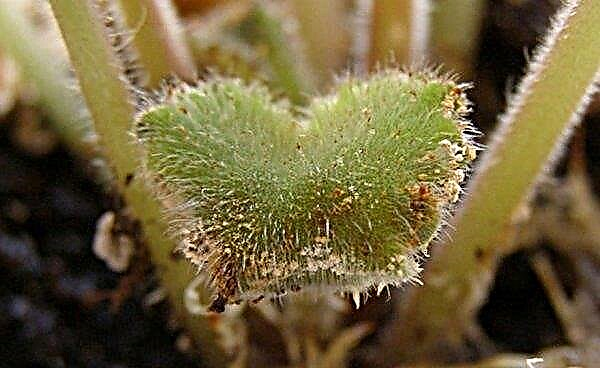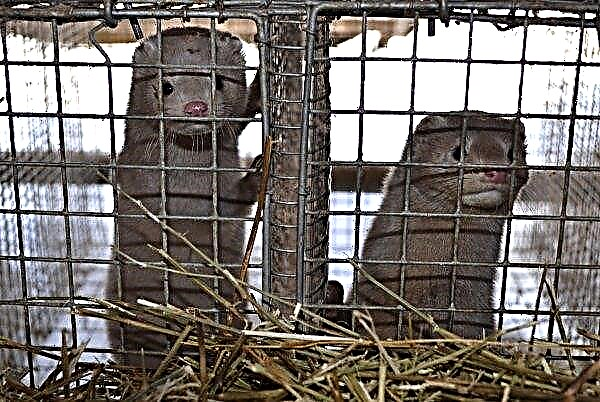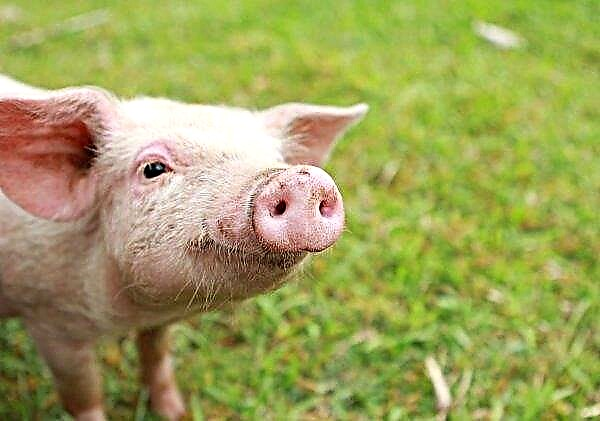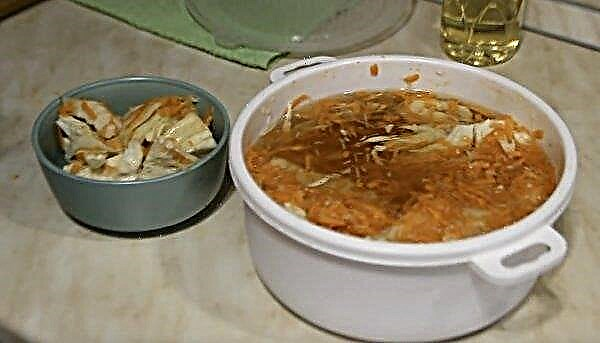In our minds, a rabbit is associated with a small fluffy animal, which is characterized by long ears sticking up. But the breeders are not asleep: one of the “inventions” in the field of animal husbandry is a new breed of giant rabbits, which, due to its external characteristics, has received an exotic name - French lop-eared ram. Representatives of this variety won the hearts of not only farmers: the breed quickly took on the status of decorative. The purpose of our article is to tell all about the fold breed.
Origin history
The history of the French ram began in the 19th century, and more specifically in 1850, and Great Britain is considered its homeland. The idea of raising rabbits with ears hanging was born by the breeder Condeniere. This man made his living by binding books. Books about breeding animals (in particular, rabbits) caught his eye, which aroused great interest in him. The breeder decided to engage in breeding, and soon English breeders joined him. For breeding, we chose the breed of English rams and Norman (Rouen) rabbit giants. The mercy and good nature of these animals quickly made them universal favorites, and the breed spread throughout the world.
For breeding, we chose the breed of English rams and Norman (Rouen) rabbit giants. The mercy and good nature of these animals quickly made them universal favorites, and the breed spread throughout the world.
Did you know? Representatives of giant rabbit breeds can weigh more than 25 kilograms.
Description of appearance
Although the initial factor for the creation of the lop-eared was the external factor - the hanging ears, but they brought them out as a commercial look, that is, for production purposes.
Their physique is not arched, but commercial. This suggests that the breed was bred as meat. The giant size of the animal often leads to the fact that from afar it is confused either with a small lamb or with a dog. Let us consider in more detail the external features of the French ram.
| Appearance | Features |
| Color | The most diverse. Wool can be either plain (black, white, gray, chocolate, opal, chinchilla, lilac, blue, frosty, smoky, golden and other shades), or combined (a combination of two or three of these colors). |
| Torso | It has a large elongated shape, in length reaches an average of 60–70 cm. |
| Head | Large, with a sloping forehead and puffy, heavy cheeks. The muzzle is quite wide, has a rounded shape, the bones of the forehead are clearly protruding on it. Set high. The hair on it is much shorter than on the rest of the body. |
| Eyes | May be blue or red, large. |
| The ears | Hang down, can hang 4 cm below the chin. Length - 20–40 cm, width - 15 cm. Do not curl. They do not have folds. |
| Mustache | They have an average length. The shape is bent, hang down. |
| Neck | Wide and short. |
| Paws | The front ones are short, the rear ones are long, rather massive. |
| Tail | Short, tight to the body. |
| Claws | They grow long, they need to be trimmed. |
Important! Rabbits of this breed are born with ears that either stick up or to the sides. This situation can persist for about six weeks.
Animal character
The French ram has a friendly and calm character, making it the perfect pet. It easily gets along with other pets and becomes attached to the person. Needs games and communication. But do not forget that the rabbit is more nocturnal, and in the afternoon he is not so active.

Due to the shape of his ears, he is weakly susceptible to loud sounds, so his stress resistance is an order of magnitude higher than that of his relatives. But, in order not to frighten the animal, it is not recommended to raise the rabbit in your arms (especially for children). Since the animal is a victim in the food chain, such actions can be perceived as an attack and manifest aggression. And thanks to its weight, it can easily injure a person with its hind legs.
But still, the French ram is a beast with a developed intellect, which makes it easy to train and love active games. And thanks to his love of affection and tenderness, he is quite capable of replacing a cat.
Productive qualities
A large amount of high-quality dietary meat is obtained from the French ram. If we take into account the fact that representatives of this breed grow quickly and reach impressive sizes for rabbits, then their meat productivity can be considered quite high (about 60%). The meat of the animal has a delicate taste. In addition, skins of such rodents are very popular, so it is worth carefully processing the carcass so as not to damage the fur.
In addition, skins of such rodents are very popular, so it is worth carefully processing the carcass so as not to damage the fur.
Representatives of the breed are also valued in decorative rabbit breeding. Due to their attractive appearance and complaisant nature, they quickly win the favor of people, especially children, and become their favorite pets.
Important! The physiological feature of any type of rabbit is the presence of five toes on its front legs, and four on its hind legs.
Advantages and disadvantages
Lop-eared giants have advantages over other representatives of their kind, but they are not without drawbacks.
- The advantages include:
- high meat productivity. Rodents can be killed at the age of three months;
- valuable fur of different colors;
- original, unusual appearance;
- quiet and peaceful nature, in which there is no aggression and stress resistance;
- illegibility in food.
- Cons are:
- very weak immunity;
- low fecundity, and, accordingly, reproduction of offspring;
- the large size of the animal is appreciated in meat productivity, but not in reproduction: due to the large weight of the rabbits sexual instinct is reduced;
- To keep such pets, you need a large space. In addition, they are very fond of warmth;
- the need to ensure that the furry giant does not overeat, since the lop-eared are prone to gluttony, especially rabbits.
Rules for choosing a breed
When choosing pets, we advise you to pay attention to the following parameters:
- Torso: up to 70 cm, elongated, squat. With a round, well-developed croup and a slightly hollow sternum.
- Weight: up to 5 kg.
- Head: large, with a wide forehead, drooping, humpback nose and bulging cheeks. It looks like a lamb.
- Ears: from 45 to 60 cm, hang freely on the sides of the head, 4 cm and below the line of the chin, without wrinkles and twists. Width - 10-17 cm.
- Color: plain (blue, white, black, gray), chinchilla, with tan, spotted, white with spots, etc.
- Legs: short and strong
- Fur: up to 3 cm, soft and smooth
Did you know? French sheep have poorly developed hearing. Breeders attribute this to the fact that the ears are not properly developed.
Features of care and maintenance
In order to grow healthy and strong lop-eared rabbits, you need to provide them with all the necessary conditions for maintenance and care.
Room requirements
The feather that the owner of the fold rabbit should prepare for the residence of his pet is a spacious cage. Rabbits grow quickly, and for normal life they need to be provided with free space. Experienced rabbitry recommend preparing a cage 100 cm long, 90 cm wide and 70 cm high. Rabbits are very sensitive to humidity. The "golden mean" of air humidity in which the fold will feel good is from 55 to 75%. The minimum limit is 30%, and the maximum is 80% (provided that the air temperature is +16 ºC).
Rabbits are very sensitive to humidity. The "golden mean" of air humidity in which the fold will feel good is from 55 to 75%. The minimum limit is 30%, and the maximum is 80% (provided that the air temperature is +16 ºC).
As for the optimal air temperature for French sheep, it should be kept within +18 ºC. In winter, the indicators may be slightly lower: if you provide your pet with the necessary care, it can adapt to a temperature of +8 ºC, but it’s better not to risk it, because this breed loves heat
Important! Rabbits must be protected from drafts.
In order for the body of the furry giant to function correctly, it is worth taking care of the lighting of the rabbitry. Sunlight “charges” the body with energy, due to which the animal becomes active, and also helps to increase its sanitary and hygienic condition.
But it is important not to overdo it: direct sunlight in the summer can harm the rabbit, which will affect not only its appearance (fading and deterioration of the fur), but also in general condition (overheating will make the animal lethargic).
We advise you to find out

In order for your pupil to be able to eat and drink normally, rabbits and feeders must be installed in the rabbitry. The main rule is that they must be metal or ceramic, since the rabbit can easily nibble containers made of another material. They should also be quite heavy so that your long-eared pet cannot knock over or dislodge them.
They must be installed in such a way that hanging rabbit ears do not fall there during eating or drinking, that is, they should be hanging containers. It is important to monitor the cleanliness of drinkers and feeders daily. Make sure that there are no sharp, protruding elements in the cage that your pet might hurt.
Important! In winter, cages with lop-eared must be moved to a warm room, because they can easily freeze ears by touching them on a cold floor.
Feeding ration
The good appetite of a lop-eared pet is not always its plus: the animal knows no limits, it can chew something constantly. Therefore, the owner's task is to monitor the diet of his pet and protect it from overeating. So, it is recommended to feed these giants no more than 3 times a day.
Their diet should consist of:
- Dried grass (if it’s summer outside). A great option is the leaves and stems of dandelions, nettles, plantain, yarrow. In winter, grass is replaced with hay, whose stocks should be made in the summer.
- Vegetables - melons, root crops (carrots, beets), cabbage.
- Cereal. It is recommended to feed with oats, wheat.
- Fruit. Rabbits love to feast on apples, pears, bananas.
- Feed.
Important! It is strictly forbidden to add beans, rhubarb, tomatoes to the rabbit diet.
Be sure to provide your pet with clean water, change it daily. You can’t drink French sheep cold water, it should be rather warm.
To maintain immunity and the health of the body of furry pets, it is recommended to feed them with vitamin and mineral supplements (iron, copper, manganese, iodine, cobalt, zinc). You can independently choose a diet from products that are rich in these trace elements, or you can use premixes, where veterinarians have chosen everything for you.
For example, add the Ushastik premix to your pet’s food, which, in addition to the trace elements mentioned, is rich in vitamins A, E, B2, B12, D3. In winter, when the lop-eared organism is especially in need of support, it is recommended to put pieces of chalk, iodized salt in it in the feeder or cage.
Video: ushastic premix
Care and hygiene
The advantages of this breed include the fact that its representatives do not require special care and hygiene. The main thing is to clean the cells on time (1-2 times a week) and disinfect them (1 time per month). As disinfectants, bleach (10% solution), quicklime (20% solution), soda (10% solution), carbolic acid (35% solution) are used.
With regard to hygiene, several points should be taken into account:
- The ears. They must be thoroughly and regularly cleaned of contaminants. Cleaning tool - cotton ear buds. When cleaning rabbit ears, do not push the cotton bud too deeply: you can harm the eardrum.
- Wool. It must be thoroughly combed out from the tundra.
- Claws. Trim every 4–5 months.
- Vaccinations. Vaccinate your pupils against myxomatosis and other diseases.
Important! It is not recommended to bathe fold.
Breeding and okrol rabbits
In order to get healthy offspring from your French sheep, you need to carefully familiarize yourself with the features of their breeding and fencing.
Video: rabbit okrol
Selection Principles for Reproduction
For breeding, you need to select the best representatives of the breed. Color - to your liking. The main thing is that the animal is healthy and active. Rabbits that are obese will not work.
The female, which was chosen to continue the genus, needs to be settled in a separate cage and slightly prepared for future motherhood. To do this, she picks the right nutritious diet.
Okrol and care of young growth
The optimal age of rabbits for the first mating is six months, and the most favorable time for okroli is spring, approximately April, that is, mating should be carried out in March. The period of gestation of rabbits is 30–32 days. The rabbit's pregnancy proceeds, as a rule, without complications. Lop-eared females are excellent mothers; they do not abandon their cubs and take care of them. The necessary care in the first weeks of life to rabbits is provided by the female.
The rabbit's pregnancy proceeds, as a rule, without complications. Lop-eared females are excellent mothers; they do not abandon their cubs and take care of them. The necessary care in the first weeks of life to rabbits is provided by the female.
Mating is recommended 2-3 times a year. The first round is without complications, the rabbit will not need human help. But the following will be more difficult, so the owner needs to be on the alert. Every year, childbirth will be complicated, due to the physiological characteristics of the breed. In this regard, it is worth remembering that it is not worth mating three-year-old females, as they, most likely, will not be able to give birth and may die during the round-up.Important! On average, for one bunny rabbit brings 4–7 rabbits, rarely - 9. In this case, the rabbit can refuse “extra” children. In order for all the rabbits to survive, experienced rabbits recommend the simultaneous mating of several females, which, if necessary, will be able to toss the rabbits after the rounding.
Baby rabbits feeding
In the early days of life, rabbits feed exclusively the rabbit. They eat milk once or twice a day. Two-week-old rabbits begin to crawl actively, study everything around, even try the food that their mother feeds. On the 28th day, the rabbits can be excommunicated from the sucral mother (that is, you can completely transfer them to a new diet), or they can live with her up to 3 months of age. Initially, the furry ration consists of fresh, granular feed. You can also cook them food yourself at home. For this you need hay, legumes, grains, boiled potatoes, carrots, reverse. That is, portions should be complex.
Initially, the furry ration consists of fresh, granular feed. You can also cook them food yourself at home. For this you need hay, legumes, grains, boiled potatoes, carrots, reverse. That is, portions should be complex.
Important! You can’t feed the rabbits with wet grass, this can lead to indigestion, diarrhea.
Vaccination
Since French rams are prone to diseases (infectious, hemorrhagic, myxomatosis), veterinarians recommend rabbits to systematically vaccinate their pets. You must be vaccinated to prevent myxomatosis. The first vaccination is recommended when the rabbit's weight is half a kilogram. This is approximately 45 days old. Before you get vaccinated, you need to carry out prevention from worms. As you can see, in order to become the owner of a fluffy pet - a lop-eared rabbit, you need to carefully familiarize yourself with the features of the care and maintenance of this handsome man. With the correct organization of living conditions, the pet will thank you not only for its external beauty and complaisant character, but also for delicious tasty meat.
As you can see, in order to become the owner of a fluffy pet - a lop-eared rabbit, you need to carefully familiarize yourself with the features of the care and maintenance of this handsome man. With the correct organization of living conditions, the pet will thank you not only for its external beauty and complaisant character, but also for delicious tasty meat.

